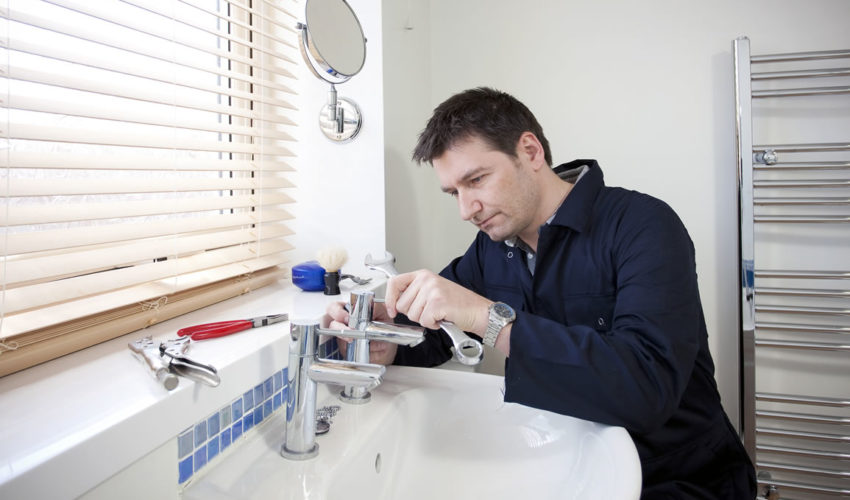Along with the recent winter storm and prolonged freezing temperatures came a deluge of plumbing disasters. Even if you made it through unscathed, we’re all at greater risk now for unexpected plumbing issues that may show up later. Whether you already suspect a leak—maybe you’ve received a water bill that’s higher than expected—or want to invest a little time in making sure that everything indeed weathered the storm, we made this list to serve as a guide to help find leaks even if they don’t want to be found.
Kitchen Sink
An excellent place to look for small leaks developing is under the sink. Often, the culprit is either the garbage disposal or the water supply line. To find leaks around and on the garbage disposal, unplug it from the wall and turn off the circuit at the breaker box. Plug the sink above with a stopper, fill the sink with water and add a few drops of food coloring. Watch to see if colored water appears below. It might come from where the drain meets the garbage disposal, where the dishwasher hose attaches, or from the bottom of the disposal. Use a flashlight and a rag to help pinpoint a leak. If there’s a leak toward the top, the flange inside the drain may need to be tightened and resealed. If water is leaking from the disposal side, you may need to tighten a connection to the drain line or the dishwasher hose. Look for worn gaskets and replace them if needed. If you see water stains or pooling water on the bottom of the cabinet, you may need to check your disposal unit and possibly repair or replace it.
Water supply line leaks are also common under the kitchen sink. Be sure to check the supply line, especially if your kitchen sink is on an exterior wall where colder temperatures on the pipes can lead to splits and damage. To fix a leak, you may need to tighten a connection. Check the supply line next and replace it if needed. By the way, this could be a good time to fix that annoying, dripping faucet.
Running, Leaking Toilets
Does your toilet ever continue to run after being flushed? While it may seem like no big deal, over time, you can run up an over-sized water bill. A leaking toilet tank can mean the flapper is no longer keeping the water in the tank between flushes, and a constant stream leaks into the bowl. Unfortunately, many homeowners let the problem go on for a while, and municipal water departments—San Antonio Water Systems (SAWS), for example—aren’t often amenable to reducing the bill or refunding the account. Check for leaks by adding a few drops of food coloring into your toilet tank. Wait a few minutes, then check the bowl. If the color is seeping through to the bowl, you probably need a new flapper. Or you may need a new seal between the tank and bowl.
Washer Hose Leaks
Regular checks of washing machine hoses are a must because the hoses are tucked away and out of sight. It’s easy for a hose to develop a leak and make a big—and possibly expensive—mess that can go unnoticed for some time.
This much-used appliance has three hoses — warm water, cold water, and a drain — also known as three potential leak sources. To see them, carefully pull the washer away from the wall. Don’t disconnect the hoses, but slide the appliance out far enough that you can see the hoses. Now start a short wash cycle, and keep your eye on all three hoses throughout. If you notice any drips or leaks, turn off the machine and the water supply knobs (usually by turning them clockwise). If the leak is coming from a hose, replace it. Choose a steel-braided model that’s leak-resistant. If the leak is coming from the water supply valves, it’s time to call a pro for repairs.
Make sure that the hoses are well connected after you reposition the washing machine. It’s a common problem to have a hose pop off after completing repairs, and this can flood your whole house! It’s recommended to change the washer hoses (hot & cold, not the drain hose) every 5 years. Because they are under pressure most of the time, they don’t last very long. Not to mention they can burst in the middle of the night.
Pipe Insulation
While you’re doing your spring inspection, look for any exposed pipes in your attic, basement, crawl space, and even outside. Insulating exposed pipes helps prevent freezing, cracking, and the leaks that can result. You should look for damage to PVC pipes, such as fraying and splits. By making sure you have insulation for any exposed pipes in the attic or along outer walls, you can help prevent water loss during a freeze.
Now is the right time to fix potential plumbing issues before they get worse. Call (210) 658-0111 and schedule an inspection today to save time, money, and stress down the road.


